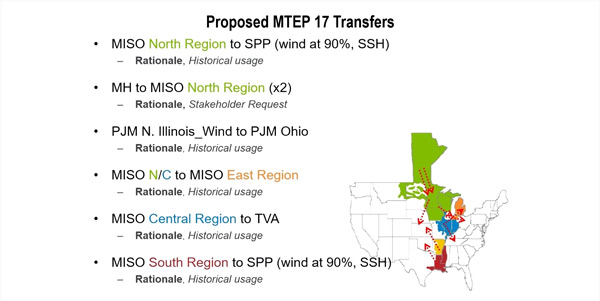CARMEL, Ind. — MISO last week presented a strawman proposal for non-transmission alternatives that includes redispatch, load shed, reconfiguration and remedial action schemes.
The Planning Advisory Committee is currently working on Business Practices Manual 020, which outlines the process for considering non-transmission alternatives. (See “Rules on Non-Transmission Alternatives Ready for PAC Review,” MISO Planning Subcommittee Briefs.)
At the April 18 Planning Subcommittee meeting, MISO officials provided details of the alternatives:
- The generation redispatch option would require an evaluation to “demonstrate that there are sufficient generation units that are available to provide the incremental capacity necessary to maintain loadings and voltages within applicable [ratings], without reliance on any single unit,” MISO proposed. The RTO said no more than 10 individual units or 1,000 MW will be used in any redispatch plan. Candidates for redispatch include all network resources and energy resources, and participating generators must have a distribution factor of greater than 3%. Before using a redispatch plan that requires decommitting a resource, the RTO said it will evaluate reliability and voltage without the unit. MISO will also exclude non-dispatchable units and nuclear generation from possible redispatch solutions.
- Load shed will be allowed when local planning criteria permits, MISO said. The RTO committed to flagging constraints that result in load shed of 1,000 MW or more for potential physical upgrades.
- System reconfiguration will be allowed as a corrective plan, MISO said, unless reconfiguration places noninterruptible load on a transmission radial “such that a single contingency would interrupt service to multiple customers, the reconfiguration results in opening of more than a single transmission line or the reconfiguration results in transmission flows to be routed through sub-transmission or distribution facilities.”
“All three of these come from current, real-time operating procedure,” engineer Patrick Jehring said.
- Remedial action schemes will use language pulled directly from NERC, with existing schemes allowed as acceptable corrective action plans. New schemes will be evaluated on a case-by-case basis. The evaluation will include expected frequency of need for a RAS and comparison of costs to install and maintain it compared to the cost of a transmission upgrade. “Remedial actions schemes must be far cheaper than a new line,” Jehring said.
Jehring also said most of the strawman was borrowed from existing MISO standards, but that the RTO still wants stakeholder suggestions. He asked for written feedback by May 5.
“How much risk to the load-serving capability is acceptable on the planning horizon?” Jehring asked stakeholders.
In response, they expressed concerns in particular on load shedding as a non-transmission alternative option.
Consultant Roberto Paliza of Indianapolis said MISO should be transparent when it identifies specific solutions. Paliza added that too much load shed to resolve contingencies can cause a concern and could make transmission construction more appealing. Planning Subcommittee liaison Jeff Webb agreed. “If the solution is load shed, we should be explaining why that is acceptable,” Webb said.
NRG Energy’s Tia Elliott asked if MISO could gather all transmission owners’ individual load shed criteria and consolidate it into a single document. “It varies across the footprint from transmission owner to transmission owner,” she said. “Not understanding what those variables are makes it difficult for stakeholders to make an informed decision.”
Jehring said MISO already posts such planning criteria, though not consolidated, on its website.
MISO Unveils MTEP 17 Transfer Analysis
As part of its 2017 Transmission Expansion Plan, MISO outlined a proposed analysis on a half-dozen MISO transfers.
This year, MISO is proposing to study transfers between MISO North and SPP; two transfers from Manitoba Hydro to MISO North; wind resources in Northern Illinois to Ohio (both PJM territories) using MISO transmission in Indiana; MISO North and Central to MISO East; MISO Central to the Tennessee Valley Authority; and MISO South to SPP.
Scott Goodwin, MISO transfer analysis engineer, asked for stakeholders to review the transfer selection.
This year, MTEP studies include the usual base reliability and economic studies along with a trio of specialized studies: the multiyear regional transmission overlay study, a generation retirement study and the footprint diversity study, which could identify an alternative to using SPP transmission for transfers between MISO North and MISO South. (See “Studies Could Assist in Relieving North-South Constraint,” MISO Planning Advisory Committee Briefs; “Generators Identified in MISO Retirement Analysis,” MISO Planning Subcommittee Briefs.)
MTEP 17’s scope will be finalized in December.
— Amanda Durish Cook





